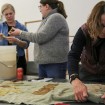Regeneration Bonus: Randal Voss
Randal Voss is sequencing the genome of salamanders. Though we share many of the same genes, the salamander genome is massive compared to our own—about 10 times as large. Voss's research focuses on axolotls—salamanders with amazing regenerative ability.
Voss says, “It’s hard to find a body part they can’t regenerate: the limbs, the tail, the spinal cord, the eye, and in some species, the lens, half of their brain has been shown to regenerate.
“I’m very fortunate to have a colleague in the department, Jeramiah Smith, who’s an expert at the ability to put small pieces of DNA together to kind of recreate the puzzle, which is the genome. We have funding from the National Institute of Health and the Department of Defense to sequence the axolotl genome and provide this blueprint for the first time.
“We’ve been measuring the abundance of gene expression transcripts from genes during the course of limb regeneration. Over a time course, collect the tissue, isolate RNA from the tissue, then use that RNA and hybridize it to a gene chip, which allows you to estimate the expression of 20,000 genes at one time. You do that over and over and over again. The last four years we’ve collected eight million estimates of gene expression from that approach. We’re building a model for how genes are turned on and how turned off over very small time scales so that we can have this blueprint to move forward with.”
With a partner at the University of Dayton, Voss is looking at the loss of regenerative ability in the eye as a salamander ages. “Early on in life, axolotls can regenerate their lens. But at some point in time, around 28 days after they hatch, that plasticity goes away and they can’t regenerate the lens. So I’ve been working with that group trying to identify the genes that might explain that.”
Voss is also starting a new collaboration with an orthopedic surgeon at UK to study knee joint regeneration.
Voss says, “Over the course of say 10 to 15 days, the salamander will successfully regenerate a complete joint. That blows the orthopedic surgeon’s mind because that would be the Holy Grail in their field to understand how to orchestrate joint regeneration in a human.”
Learn more about the unofficial regeneration “cluster” of researchers at UK.


